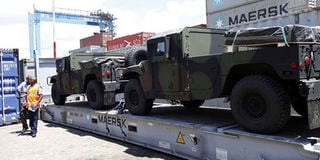Prime
East African countries buy modern equipment for armies

Military vehicles spotted at the port of Mombasa on April 11, 2019. The EastAfrican could not immediately establish for which country they were destined. NMG PHOTO
What you need to know:
- Kenya remained the region’s top military spender, splashing out $963.5 million in 2017, followed by Tanzania at $593.1 million, then Uganda at $444.6 million and Rwanda at $111 million.
- Burundi spent $63.9 million, while South Sudan used $72 million, down from a whopping $1.1 billion in 2014.
East African countries have, in the past three years, been on a military hardware-shopping spree, upgrading their aircraft, vehicles, arms and other equipment.
A new report by the Stockholm International Peace Research Institute (Sipri) for 2018 shows that in the region, Kenya topped the purchases, with six aircraft orders. Nairobi expects the planes this year.
Kenya also received eight second-hand Airbus AS-550C3 light helicopters as aid from the US last year.
The six orders include three C-27J Spartan transport aircraft from Italian firm Leonardo, which will cost $200 million.
These are meant to replace the ageing fleet of De Havilland Canada DHC-5 Buffalos the Kenya Defence Force (KDF) has.
The other three are M28 Skytruck light transport and passenger planes from Poland, which Kenya ordered in 2016.
The KDF also received 12 Bastion Armoured Personnel Carriers (APCs) from the United States as a donation to help secure its borders and promote peacekeeping in Somalia, where its troops have been serving under the African peacekeeping mission, Amisom.
For the APCs, Kenya bought 12 MD5 diesel engines from France, Sipri says.
In Uganda, the Uganda People's Defence Forces (UPDF) will this year receive 45 South African-manufactured Mamba APCs for assembly at the Armoured Vehicle Manufacturing and Assembly Facility in Jinja, which President Yoweri Museveni opened last August.
Last year, the UPDF received four 850 Military Patrol Boats from local firm Twiga Services and Logistics under a contract from Impala Services and Logistics, as it sought to modernise its marine patrol equipment.
The Sipri report shows that Uganda ordered one DA42 surveillance light aircraft, a model that in 2016 put it in UN's crosshairs after arms monitors accused Kampala of being used by South Sudan to purchase the aircraft, amid an arms embargo on Juba.
Other African countries that have the DA42, used mostly for reconnaissance or pilot training, are Nigeria, Ghana, South Sudan and Niger.
According to the report, Tanzania last year received three Airbus AS-350 helicopters from an order of 10 it had made in 2017.
Dar had ordered eight AS-350/AS-550 Fennec light helicopters and two AS-532 Cougar/AS-332 transport helicopters from Romania.
In Rwanda, the military last year acquired Red Arrow-9 anti-tank missiles, which it had ordered from China in 2016. These came together with three CS/SH-1 122mm self-propelled guns, ordered in 2017.
The military unveiled the anti-tank missile at the combined arms exercise at the Gabiro Combat Training Centre in December last year.
Even as the region modernises its militaries, there has been a noted drop in the overall spending, attributable to South Sudan’s cutback of more than 50 per cent in 2017.
In that year, the region spent $2.73 billion in military-related expenses, down from $2.78 in 2016 and a high of $3.6 billion in 2015, according to data from Sipri.
Kenya remained the region’s top military spender, splashing out $963.5 million in 2017, followed by Tanzania at $593.1 million, then Uganda at $444.6 million and Rwanda at $111 million.
Burundi spent $63.9 million, while South Sudan used $72 million, down from a whopping $1.1 billion in 2014.
Sipri is expected to release the 2018 expenditure figures in May.



